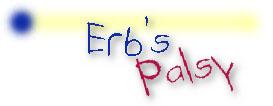



BRACHIAL PLEXUS/ERB'S PALSY
Brachial Plexus Palsy, also known as Erb's Palsy, is a paralysis that results from a birth injury. During the birth of a child a situation known as shoulder dystocia may occur during which the infant becomes stuck on the mother's pubic bone. In an effort to extract the baby from the birth canal, excessive traction may be applied to the infant's head that causes damage to the nerves of the brachial plexus. The result can be torn or stretched nerves, broken clavicles, and broken humerus bones.
It is theorized that the number of these births is on the rise because women are bearing larger babies and the government, insurance companies, and hospitals are discouraging cesaerean sections.
Although most infants who experience shoulder dystocia during the birth process recover without any long term effects, there is a small percentage who suffer nerve damage to the brachial plexus nerve group located between the neck and shoulder. This type of injury results in a variety of paralyses to the arm, shoulder, wrist, hand and/or fingers. Without treatment the injury can result in chronic pain, disfigurement, scoliosis, a shortened limb, as well as a loss of function. These children need physical and occupational therapy for years.
Unfortunately, a great number of pediatricians, orthopedic surgeons, and other health care professionals are unaware that surgical techniques exist to repair some or even most of the damage, restoring function to the affected limb. Too often they take a "wait and see" approach, losing crucial time for the injury to be addressed early on. Although some parents are fortunate to find a physician knowledgeable of the medical centers that perform these surgeries, many are not.
Nerve grafting surgeries exist now to repair the brachial plexus nerves but must be performed by one year of age, optimally between four and six months of age. Muscle and tendon transfer surgery is also possible after one year of age. Several hospitals offer surgeries to repair brachial plexus damage.
It is imperative that the public be made aware of this birth injury for two reasons. First of all, there may be affected infants or children whose parents do not know what the injury is and how it should be treated. Physical therapy should be started immediately. Secondly, in the majority of these births, the injury is preventable. There are risk factors apparent during the pregnancy that should warn the attending obstetrician or midwife of an impending shoulder dystocia.